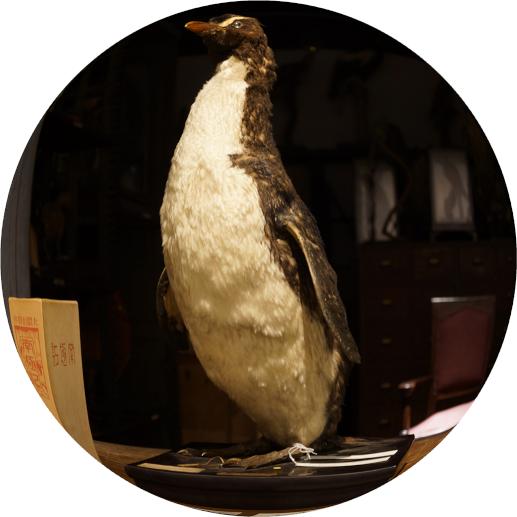Special Exhibition "The History of an Anonymous Penguin"
2014.01.19-2014.03.02
STUDIOLO
The history of one specimen from the Yamashina collection entrusted to the Intermediatheque is newly certified. Through this special exhibition, we hope that the audience feels the epoch when people tried to conquer both Poles, as well as the biological specialization of penguins and the long history that this individual penguin experienced.
Nobu Shirase (1861-1946), an Imperial Army lieutenant, conducted the first Japanese exploration of Antarctica in 1910. Their initial aim was to be the first to conquer the South Pole, but Roald Amundsen achieved it during their travel. Shirase then switched his objective to scientific research and collected various specimens including 45 penguins.
According to Keiichi Tada, the secretary of Shirase’s expedition team, the team found a penguin beside the ship and caught it with a net on Feb. 17 1911, offshore in New Zealand (47’ 52”S, 175’ 04”E). This penguin died in Mar. 10 and they brought back the skin to Japan to make a stuffed specimen. They offered the specimen to Count Shigenobu Okuma, sponsor of the exploration, who then donated it to the Meiji Emperor. This is supposedly the first penguin collected by the Japanese around the Antarctic zone.
At first, the bird was recognized as a juvenile Adelie Penguin. After being stored in the Biological Laboratory of the Imperial Household established in 1928, the specimen was labeled “Rock-hopper Penguin” but the date and location of collection was not recorded on the label. In 1995, the specimen was moved to the Yamashina Institute of Ornithology and it was entrusted to the Intermediatheque in 2013.
In 2013, Junichi and Hitomi Oshima, private penguin researchers, studied the history of Shirase’s exploration and found the stamp on the base plate of the specimen that proves Okuma’s donation. With this study, the specimen was identified as the first Penguin specimen caught by Shirase’s team and donated to the Emperor. From the collecting location and black fore rim on the under surface of flippers, the Yamashina Institute re-identified the species as Erect-crested Penguin. 102 years have past after this individual was caught.
This individual is supposed to be juvenile because its characteristic crest feathers are too short. Also the coloration on the leg is different: this genus has pink legs. It could be because of a coating degradation or a mistake on the painting. The posture is rather similar to Diver (Gavia) or Cormorant, because the craftsmen then made the stuffed specimen without knowing about real penguins.
[Organizers]The University Museum, The University of Tokyo (UMUT)
[Support]Yamashina Institute of Ornithology + Jinchodowhompo

